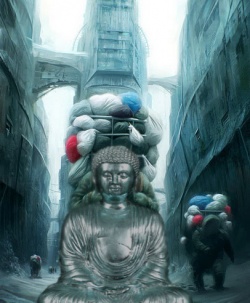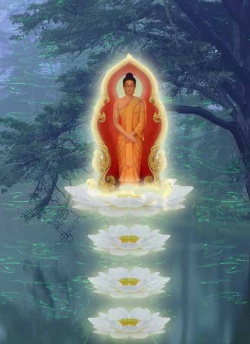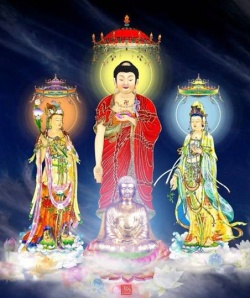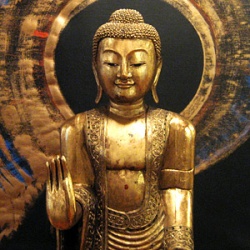Paramartha
- This article is about Indian monk for Buddhist term Paramārtha meaning highest truth see Paramārtha (truth)
Paramārtha (Sanskrit: परमार्थ Paramārtha; traditional Chinese: 真諦; simplified Chinese: 真谛; pinyin: Zhēndì) (499-569 CE) was an Indian monk from Ujjain in central India, who is best known for his prolific Chinese translations which include Vasubandhu's Abhidharmakośa.
Paramārtha is considered one of the greatest translators of sutras in Chinese Buddhism, along with Kumārajīva and Xuanzang.
Biography
Paramārtha was born in 499 CE in the autonomous kingdom of Malwa in central India, at the end of the Gupta Dynasty. His given name was Kulanātha, meaning "savior of the family", and his parents were Brahmins belonging to the Bhāradvāja clan.
His Buddhist name of Paramārtha means "the ultimate meaning," parama: uppermost, artha: meaning. In the Buddhist context, this refers to the absolute, as opposed to merely conventional truth.
Paramārtha (真諦, 499–569) means the highest truth.
He was from Ujayana, the capital of Avanti, in northwestern India.
He belonged in the Brahmin caste, and his family name was Bhārata.
Intelligent and eloquent, in his youth he visited many kingdoms, studied under various teachers, and became versed in the four Vedas.
He also studied the Tripiṭaka and mastered the Mahāyāna doctrine.
In 546, the first year of the Zhongdatong (中大同) years of Emperor Wu (梁武帝) of the Southern Liang Dynasty (南梁, 502–57, the third of the four successive Southern Dynasties), Paramārtha arrived in Nanhai County (南海郡), in present-day southern Guangdong Province, bringing with him 240 folios of Sanskrit texts.
To see the emperor in his capital city, Jianye (建業), present-day Nanjing, Jiangsu Province, Paramārtha traveled intermittently for two years.
Upon his arrival in 548, Emperor Wu, a devout Buddhist, revered him and settled him in the palace to do translation work. However, in 549, a rebellion broke out, Jianye fell, and Emperor Wu starved to death in prison.
Then Paramārtha went south, moving from province to province. Wherever he stayed, he continued to translate Sanskrit texts into Chinese. In the twenty-three years between his arrival in China in 546 during the Southern Liang Dynasty and his death in 569 during the Southern Chen Dynasty (南陳, 557–89), Paramārtha translated into Chinese sixty-four texts in 278 fascicles, which were only a portion of the Sanskrit texts he brought to China. Of the sixty-four Chinese texts, only thirty are extant.
He, Kumārajīva (鳩摩羅什, 344–413), Xuanzang (玄奘, 600– or 602–64), and Yijing (義淨, 635–713) are known as the four great translators.
Paramārtha translated many sūtras from Sanskrit into Chinese.
For example, in 557, he translated the Sūtra of the Unsurpassed Reliance (T16n0669) in 2 fascicles; in 562, he translated the Diamond Sūtra (T08n0237); in 563, he translated the Sūtra of the Dharma Door with a Broad Meaning (T01n0097). However, his translation of the Sūtra of the Golden Radiance is lost.
Paramārtha also translated from Sanskrit into Chinese many treatises, among which the most significant are texts 1559, 1593, 1595, 1610, and 1666. He is revered as the founding patriarch of two Chinese Buddhist schools.
The first school is founded on text 1559 (T29n1559) in 22 fascicles, which is the Chinese version of Vasubandhu’s (世親, circa 320–80) Commentary on the Treasury of the Abhidharma (Abhidharma-kośa-bhāṣya).
The second school is founded on texts 1593 and 1595. Text 1593 (T31n1593) in 3 fascicles is the Chinese version of Asaṅga’s (無著, 4th century) Treatise on Adopting the Mahāyāna (Mahāyāna-saṁparigraha-śāstra); text 1595 (T31n1595) in 15 fascicles is the Chinese version of Vasubandhu’s commentary on Asaṅga’s treatise.
These two schools thrived during the Tang Dynasty (618–907) because Paramārtha’s students diligently propagated the teachings in these treatises.
Then the first school declined into oblivion, and the second school gradually merged into the Consciousness-Only School, founded later by Xuanzang.
Text 1610 (T31n1610) in 4 fascicles is the Chinese version of Vasubandhu’s Treatise on Buddha Nature.
Text 1666 (T32n1666) is the Chinese version the Treatise on Eliciting Faith in the Mahāyāna, written by Aśvaghoṣa (馬鳴, circa 100–60) from central India. These two treatises, which discuss Buddha nature, true mind, Tathāgata store, inherent awareness, and ālaya consciousness, are highly valued by all Buddhist Schools of China.
Paramārtha became a Buddhist monk in India and received support from royalty for his travels to spread the teachings of Buddhism. He most likely received royal patronage from Bālāditya II or Kumāragupta III.
The Maukhari ruler Dhruvasena I may have also supported Paramārtha, as his kingdom was a well-known bastion of the type of Yogācāra teachings advocated by Paramārtha.
The first destination of Paramārtha was the kingdom of Funan, or pre-Angkor Cambodia. Here in Funan, Paramārtha's reputation grew to the extent that Emperor Wu of Liang sent ambassadors to bring Paramārtha to the Chinese imperial court. Paramārtha arrived in China through Guangdong (then called Nanhai) on September 25, 546 CE.
The conditions of Paramartha's arrival at the capital are described in a Chinese introduction written by Pao Kuei in 597 CE:
During the Ta-t'ung period the emperor sent a rear guard Chang Szu to Funan to send back to China eminent monks and Mahayana sastras and sutras of various kinds.
This country (Funan) then yielded in turning over the western Indian Dharma Master from Ujjain, namely Paramartha, who in Liang was called Chen-ti, and many sutras and sastras in order to honor the emperor.
After Dharma Master Paramartha had traveled to many kingdoms he had settled in Funan. His manner was lively and intelligent and he relished details in scriptural texts and profound texts, all of which he had studied.
In the first year of T'ai-ch'ing (547) he went to the capital and had a visit with the emperor who himself bowed down to him in the Jeweled Cloud quarters of the palace in reverence to him, wishing for him to translate sutras and sastras.
In China, Paramārtha worked with a translation team of twenty accomplished monks. Paramartha's work was interrupted by political events and the general chaotic state of China during this period, which included the murder of Emperor Wu.
Several years later, Paramārtha was able to continue translation efforts in earnest with his translation team, beginning with the Golden Light Sutra (Skt. Suvarṇaprabhāsa Sūtra). During much of his later life, Paramārtha continued a pattern of continually translating texts while traveling from region to region in China.
He also continued to review his older translations for any areas in which the words and the general meaning were in conflict. By 563 CE, Paramartha had won prominence throughout southern China and had acquired a supportive following of disciples, many of whom traveled great distance to hear his teachings, especially those from the Mahāyāna Saṃgraha.
Despite his success in China, Paramārtha wished to return to India toward the end of his life, but felt that this journey back to the west would be "impossible." Instead, he accepted the patronage of Ouyang Ho and continued his translation efforts at a rapid pace. In 569 CE, at the age of 70, he died, and a stūpa was built in his honor.





